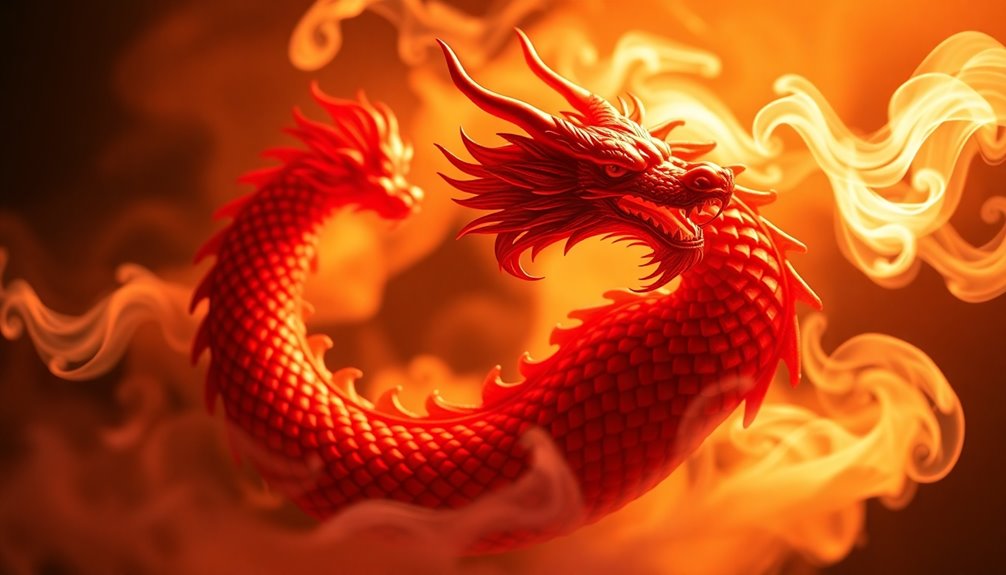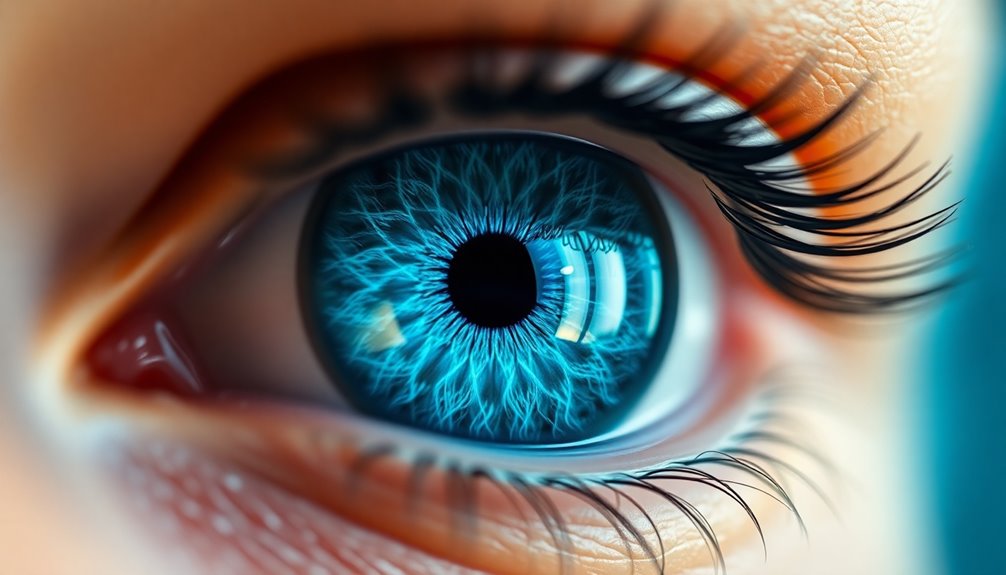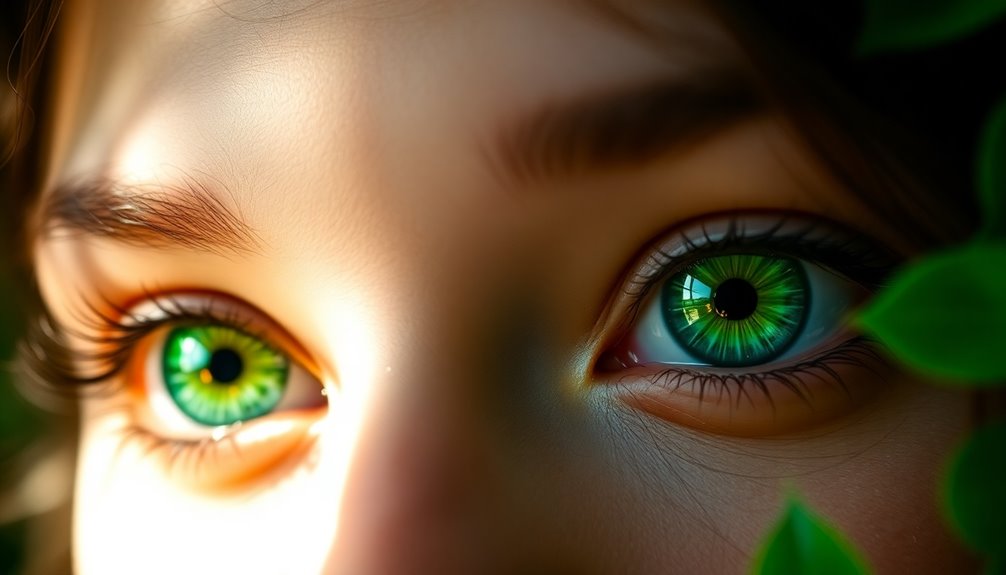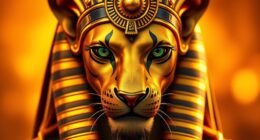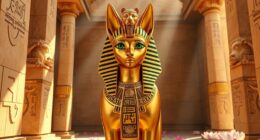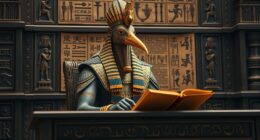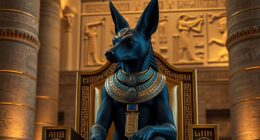The white dragon symbolizes purity and protection, standing as a guardian of mystical realms. In various cultures, it embodies clarity and spiritual awakening, connecting humanity to nature's essence. In Chinese mythology, it represents good fortune and safeguards water essential for life. Historically, it served as a powerful emblem for the Anglo-Saxons in battles. Modern interpretations often portray it as a noble figure in fantasy literature, promoting themes of emotional healing and spiritual growth. If you want to uncover the deeper layers of its symbolism and significance, there's much more to explore on this enchanting creature!
Key Takeaways
- The white dragon symbolizes purity, clarity, and spiritual awakening, acting as a guardian in various mystical traditions.
- In Chinese culture, it represents nobility and good fortune, safeguarding essential water sources for agriculture and communities.
- The white dragon holds historical significance, representing the Anglo-Saxons and embodying themes of honor and resilience in Western legends.
- It serves as a powerful symbol for emotional healing, guiding individuals towards wisdom and removing negative influences.
- In modern interpretations, the white dragon is depicted as a noble protector, enhancing themes of adventure, transformation, and spiritual growth in storytelling.
Symbolism and Origins
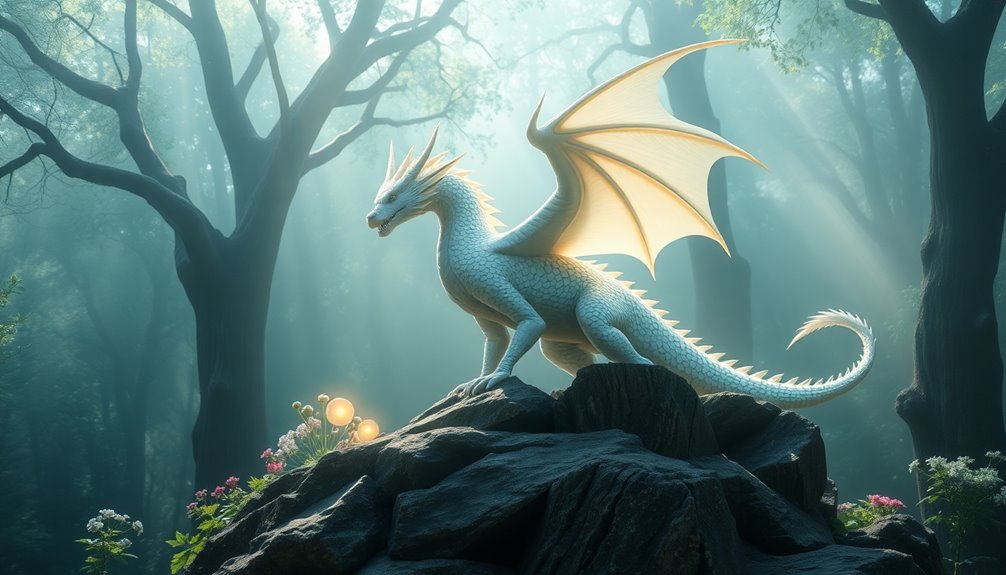
The white dragon serves as a powerful symbol across various cultures, embodying themes of purity, clarity, and spiritual awakening, particularly in Eastern traditions. When you think of the white dragon, envision it as a beacon of light guiding you on a path of self-discovery and enlightenment. In Welsh mythology, the white dragon symbolizes the Anglo-Saxons, often depicted in opposition to the red dragon, which represents the Britons. This struggle highlights the historical conflicts between these two groups.
The origins of the white dragon trace back to tales like *Historia Brittonum*, where it signifies the Saxons' presence in Britain. The legend of Vortigern, who discovers two dragons fighting, further solidifies its significance. In some versions, the young Merlin predicts the outcome, adding a mystical layer to the narrative. The white dragon also embodies the light of consciousness, reflecting its association with higher realms of consciousness and spiritual awakening.
You might also encounter the white dragon in various literary and ceremonial contexts, where it symbolizes heritage and cultural identity. While it has, at times, been associated with controversial ideologies, its core meaning remains a representation of purity and the quest for clarity—an enduring symbol across time and cultures.
Mythological Context

In exploring the mythological context of the white dragon, you'll find rich representations in both Eastern and Western cultures that highlight its diverse functions and meanings.
In Chinese mythology, the white dragon is one of the Four Symbols, representing the West and linked to autumn. It's a guardian of water, controlling rain and rivers, crucial for agricultural success. Often depicted as a long, serpentine creature, it embodies purity, nobility, and good fortune, playing a significant role in festivals celebrating prosperity. The White Dragon's association with water further illustrates its importance in ensuring bountiful harvests and sustaining life in ancient societies, much like how prophetic dreams can offer guidance and insight into future events.
Conversely, in Western cultures, particularly within medieval legends, the white dragon symbolizes honor and is tied to noble houses. In Welsh mythology, it represents the Saxons in the tale of Vortigern, where it battles the Red Dragon, embodying the struggle between two factions. This fierce creature contrasts with the benevolent nature seen in Eastern traditions, often representing the balance of light and dark in Celtic mythology.
Both cultures view the white dragon as a protective force, safeguarding communities and enhancing positive energy. Its mythological tales intertwine with human experiences, showcasing its role as a spiritual guardian and a symbol of transformation.
Cultural Significance
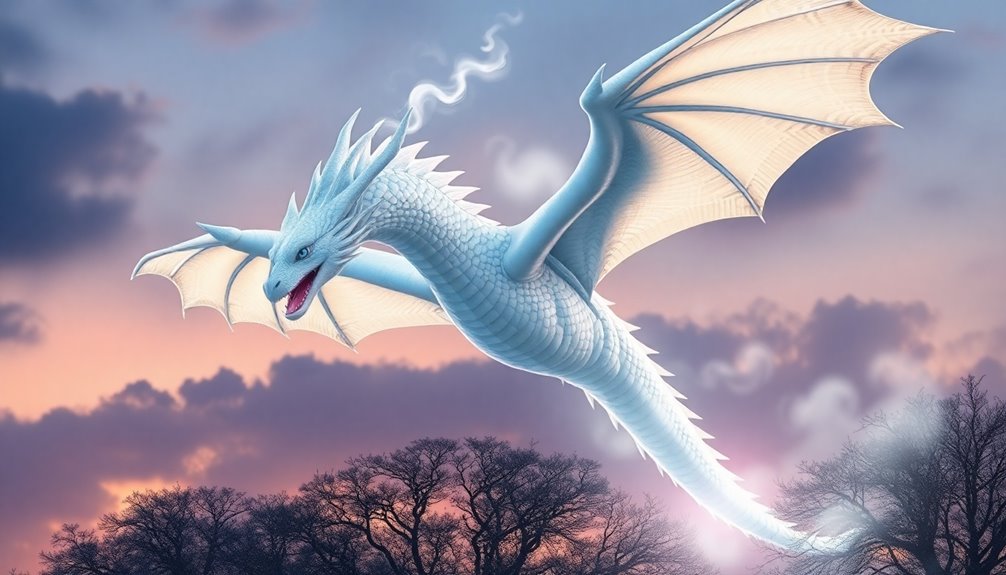
Cultural significance of the white dragon spans various traditions, reflecting its multifaceted nature. In Chinese mythology, it symbolizes purity and nobility, representing the West and autumn among the Four Symbols. This dragon controls water, rain, and rivers, essential for agricultural societies, while embodying good fortune and immense power.
Unlike its Eastern counterpart, the white dragon in Western lore, particularly medieval legends, often takes on a more fierce and destructive persona. It appears in tales by Geoffrey of Monmouth and resonates with honor and noble houses. Notably, the white dragon has also been linked to historical conflicts between Saxons and Britons, illustrating its role in shaping cultural identity.
In modern culture, the white dragon inspires artists, writers, and filmmakers, often depicted as a noble character in fantasy novels and films focused on adventure. Its image also graces various symbols and logos, such as the Royal Wessex Yeomanry cap badge.
Furthermore, in spiritual contexts, the white dragon enhances positive energy flow in Feng Shui and serves as a guide for creative and healing arts. Across cultures, it represents purity, wisdom, and transformation, embodying the delicate balance of light and dark.
This rich tapestry of meanings showcases the profound impact the white dragon has on diverse cultural landscapes.
Historical Usage
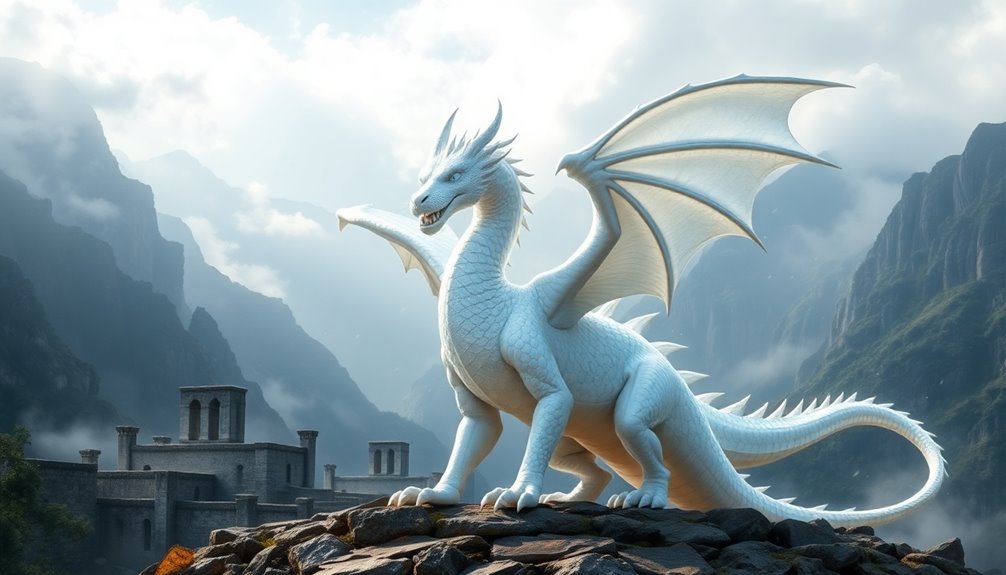
Throughout history, the white dragon has served as a powerful symbol in various contexts, particularly within the realm of British legend and identity. You might know that it was the emblem carried by Hengest and Horsa as they founded England, representing the Anglo-Saxon people and their victories over the Celtic Welsh.
In legends, it symbolized the Saxons in a prophesied battle against the Red Dragon, embodying the struggle for land and national independence. The white dragon also appeared as a battle standard for the Saxons during their conflicts with the Celts.
You'll find it was carried by notable leaders like King Alfred at the Battle of Edington and King Athelstan during the battle of Brananburgh. Even King Harold II bore the white dragon flag at Stamford Bridge and Hastings. Its depiction on the Bayeux Tapestry highlights its significance during the Norman invasion of 1066. Additionally, the white dragon became a symbol of identity for the Anglo-Saxon people, reflecting their cultural evolution over time.
Geographically, the white dragon marked the boundary between Saxon England and Celtic Wales, asserting Saxon dominance in lowland Britain. The dragon's legendary narrative, including its battles and prophecies, reflects the ongoing tension between these cultures throughout history.
Modern Interpretations
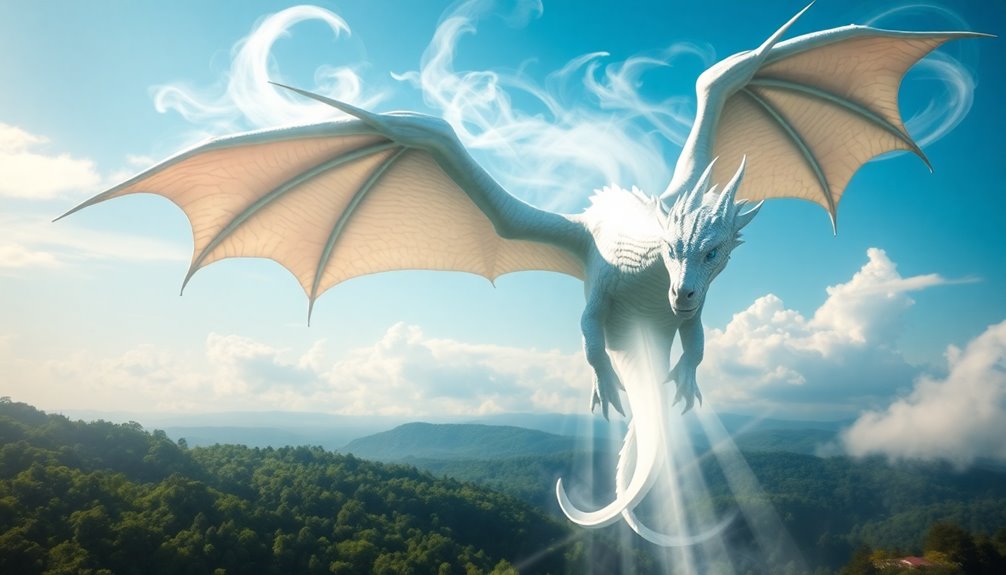
The white dragon has evolved into a multifaceted symbol in modern times, embodying purity, strength, and protection across various domains. You'll find it representing unblemished virtue and clarity, often associated with noble qualities. Its pristine white color reflects the idea of a shield-like energy that not only protects but illuminates potential. In contemporary culture, the white dragon appears frequently in fantasy novels and films, where it often plays the role of a noble character. Artists and writers draw inspiration from its majestic features, using it to symbolize hope and resilience in graphic storytelling. The dragon's presence enhances themes of adventure and exploration. Additionally, its connection to protective energies highlights the deep-rooted significance of dragons in historical contexts.
In Feng Shui, the white dragon serves as a protective figure, enhancing the flow of positive energy and safeguarding against negativity. It helps create a sanctuary, facilitating spiritual growth and energetic balance. You might also see the white dragon in popular media like video games, where it represents strength and wisdom. Its symbolism has even been adopted by various groups for transformative purposes, making it a powerful and versatile icon in modern interpretations.
Comparative Mythology

Comparative mythology reveals fascinating similarities and differences in how the white dragon is portrayed across various cultures. In Welsh mythology, the white dragon appears in the narrative of Vortigern, symbolizing the Anglo-Saxons and contrasting with the red dragon that represents the Britons. This duality showcases the conflict between these two groups, adding a layer of historical significance to the white dragon's role.
In contrast, Chinese mythology reveres the white dragon as a symbol of purity and nobility. It's one of the Four Symbols, governing water and vital for agricultural success, emphasizing its protective nature. The Black Warrior in this context embodies prosperity and safeguards against negativity, enhancing positive energy in Feng Shui.
Japanese folklore introduces another layer, where the white dragon, known as "Shirohebi," acts as a guardian spirit, particularly for rice fields. Here, it represents transformation and embodies the yang principle, promoting fertility and water control.
Through these diverse representations, the white dragon emerges as a powerful, multifaceted symbol, embodying protection, purity, and the profound connections between nature and humanity across cultures.
The White Dragon in Literature
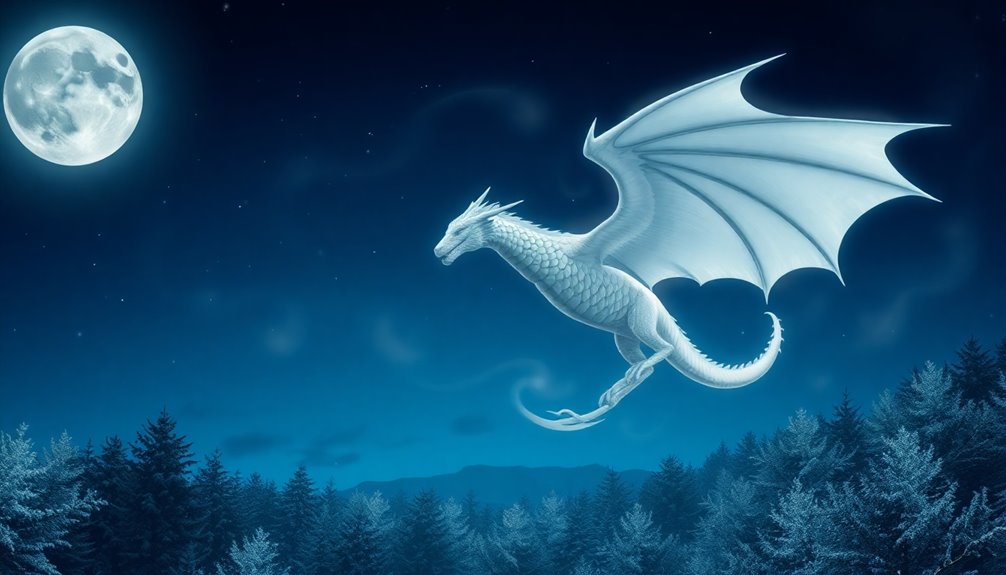
Exploring the white dragon in literature reveals its diverse portrayals and significance across various narratives.
In comic books, the White Dragon first appeared in *Iron Man* #39, created by Gerry Conway and Herb Trimpe. This character is a genius inventor and scientist, blending intellect with dragon mythology. A second version emerged in *The Amazing Spider-Man* #184, where the White Dragon is an expert martial artist, equipped with steel claws and a dragon mask that projects gas and fire. Notably, the original White Dragon's plan involved manipulating Tony Stark to create ineffective weapons, showcasing his cunning nature.
In fantasy literature, Anne McCaffrey's *Dragonriders of Pern* features the unique white dragon, Ruth, alongside Jaxom. Their bond is special and complex, marked by challenges like time travel and political intrigue, as they face the threat of Threadfall.
Historically, the White Dragon symbolizes the Anglo-Saxons in English legend, representing their victory over the Celtic Britons. This dragon plays a role in a prophecy involving battles against a red dragon.
Across cultures, the White Dragon symbolizes power, good fortune, and protection, particularly in Chinese mythology, where it embodies purity and hope amidst darkness.
Each representation enriches the narrative of the white dragon, making it a multifaceted symbol.
Spiritual Connections
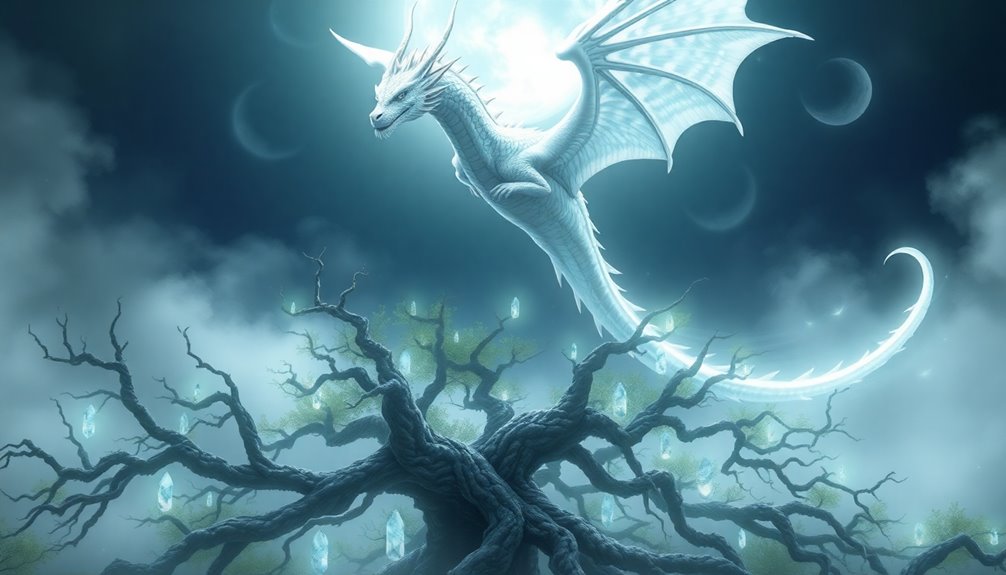
White dragons embody powerful spiritual connections, representing purity and virtue that guide individuals toward wisdom and innocence. When you connect with the essence of a white dragon, you tap into a source of spiritual guidance that encourages you to trust in your inner wisdom. This connection illuminates your path, helping you discover your inner strength and facilitating your journey of self-discovery and transformation.
These majestic beings act as purifiers, cleansing your energy fields and removing negative influences. They fill your chakras with pure love and light, bringing peace and harmony into your life. By aligning with the white dragon's energy, you can heal emotional wounds and protect yourself from harmful entities. Additionally, the white dragon serves as a guide for spiritual or soul growth, enhancing your personal evolution and understanding of the universe.
Moreover, this connection links you to Earth consciousness, allowing you to co-create healing art that benefits others. The white dragon inspires you to manifest a life filled with prosperity and divine love, empowering you to shape your own destiny.
As you embrace this unique spiritual bond, you'll find yourself inspired to create works that resonate with others, fostering transformation and healing throughout the world. Trust in the white dragon's guidance, and let it lead you toward your highest potential.
The Legacy of the White Dragon

The legacy of the White Dragon extends far beyond its spiritual connections, deeply rooted in the history and culture of the Anglo-Saxon people. This emblem, tied to legendary figures like Hengest and Horsa, represents the authentic identity of the Anglo-Saxon English. The prophecy of the White Dragon overcoming the red dragon symbolizes English victory over the Celtic Welsh, making it a powerful icon of resilience.
Throughout history, various Anglo-Saxon kingdoms, especially Wessex, adopted the White Dragon as their rallying symbol. Notable kings, such as Alfred and Athelstan, carried it into battle, embodying strength and courage. This emblem was famously carried during battles by these leaders, reinforcing its significance in historical conflicts.
As you explore this legacy, you'll see how the White Dragon signifies hope and protection, representing the determination of the Anglo-Saxon people to thrive.
The White Dragon also appears in the Bayeux Tapestry, linking it to significant events like the Norman invasion of 1066. In Anglo-Saxon lore, its dual burial with the red dragon embodies reconciliation and latent power.
You can appreciate how this legacy transcends cultures, symbolizing universal themes of courage and strength, making the White Dragon a timeless guardian of hope.
Frequently Asked Questions
What Are the Visual Characteristics of the White Dragon?
When you think about the visual characteristics of white dragons, picture their snow-white scales, especially in youth.
These scales age into mottled shades of pale blue and light gray. Their bodies are lithe and muscular, ideal for icy environments.
Notice the cluster of horns on their heads, giving them a fierce appearance.
Their lairs, often dug into glaciers, reflect their preference for cold, while traps and treasures showcase their cunning nature.
How Does the White Dragon Differ From Other Dragon Types?
The White Dragon stands out with its unique attributes compared to other dragon types.
You'll notice it lacks the fire-breathing capability common in Western dragons, instead embodying purity and wisdom. Its appearance is often more graceful, resembling serpentine forms rather than the bulky, menacing figures of traditional dragons.
While many dragons symbolize chaos, the White Dragon represents harmony and guardianship, serving as a protector of sacred knowledge and creative energies.
Are There Any Famous Artworks Featuring the White Dragon?
You'll find several famous artworks featuring white dragons, particularly in medieval and Chinese art.
In Chinese culture, they often symbolize power and good fortune, as seen in Chen Rong's *Nine Dragons*.
Additionally, while Raphael's *Saint George and the Dragon* doesn't depict a white dragon specifically, it represents dragons' symbolic role in Christian legends.
These pieces highlight the white dragon's association with purity and protection across various artistic traditions.
What Role Does the White Dragon Play in Modern Popular Culture?
In modern popular culture, you'll find the White Dragon as a multifaceted symbol of strength and purity.
It often appears as a noble ally in fantasy novels, films, and video games, embodying themes of heroism and resilience. You might see it representing hope in graphic novels or serving as a protector in various storylines.
Its majestic presence resonates in contemporary art, reminding you of the balance between nature and humanity.
How Can I Incorporate the White Dragon Symbol in My Life?
To incorporate the white dragon symbol in your life, start by visualizing it during meditation.
Imagine its purity and light guiding you on your journey of self-discovery.
You can also create art or write inspired by the dragon, allowing its creative energies to flow through you.
Surround yourself with representations—like paintings or crystals—that resonate with its protective and purifying qualities, helping you transform old patterns and embrace your inner light.
Conclusion
In conclusion, the white dragon represents purity, protection, and wisdom across various cultures and mythologies. Its symbolism as a guardian of mystical realms resonates deeply with those seeking spiritual guidance and strength. From ancient legends to modern interpretations, the white dragon continues to inspire and captivate our imaginations. Embracing its legacy can lead you to discover deeper meanings in your own life, encouraging you to connect with the mystical forces that surround us all.


